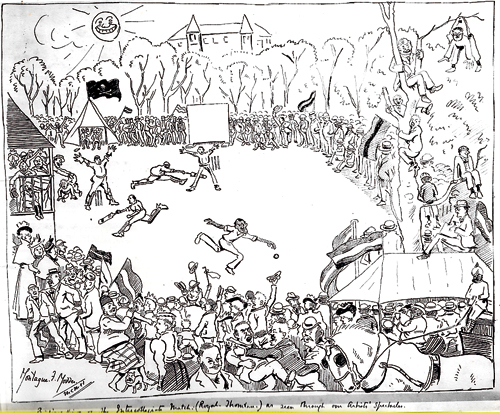Royal-Thomian Cricket Match 1911 – Montagu Frank Modder (1891-1958)
View(s): With the 140th encounter between these two schools just a little over two weeks away, it is worth portraying a scene of a cricket match that took place in the first decade of the 1900s.
With the 140th encounter between these two schools just a little over two weeks away, it is worth portraying a scene of a cricket match that took place in the first decade of the 1900s.
Images of sporting activities in the 19th century, in this country, are scarce, almost non-existent, -whether they be photographs, paintings or mere sketches in pencil or pen and ink.
Cartoons of sporting scenes in cricket are even rarer. This exquisitely pen and ink drawing of the scene of the Royal-S Thomas’ encounter by Montagu Frank Modder in 1911 is remarkable for its detail and execution.
The exact site in which the1911 match was played can only be a matter of speculation.
From the building illustrated in the background of the bird’s-eye view of the grounds it can be safely assumed that it was played in one of the pitches in the neighbourhood of Galle Face Esplanade. The site now occupied by Hotel Taj Samudra.
The drawing is studded with extraordinary details of the costumes of the crowd, both men and women spectators, tents and the trees bordering the grounds. The sketch makes it easy for us to identify some of the more important dignitaries who were spectators. Artist Frank Modder, barely 20 years of age, is, himself, perched on the ridge of the Royal College tent, making a sketch of the proceedings from a vantage point.
The sketch is focused mostly on the spectators in all manner of dress, including a man clothed in sarong, probably, an onlooker or a parent of a one of the parents of a student at Royal College, which was a secular school attended by denominations representative of all religions.
The flags of both schools are effectively delineated. One with the darker stripe representing S. Thomas’ College.
In the background, there is a tent with a banner sporting the image of a skull and cross-bone, fluttering in the wind. To me, this represents the tent meant for those of the Medical fraternity. Exclusively meant for those of the Medical College and of the Medical profession, who were old boys of both schools.
No doubt, alongside it was also a tent for the Law College students and Lawyers as well, which is not illustrated here.
In the early years of the encounter between these two schools, there were tents especially reserved for these two professions.
Probably, in the same vein as the present Mustang Tent for young and old Royalists, who want to see the match in comfort, plied with eats and drinks.
Modder has captured the revelry and confusion that ensues in these matches, which, in those days, were often interrupted by spectators running onto the field of play.
The scene also can be dated, as it is definitely before the introduction of motorised traffic into the country, as one can clearly observe an important dignitary arriving in a horse drawn carriage.
Montagu Frank Modder (1891-1958) was a versatile caricaturist and his cartoons captured the major social and political issues of the day. He was Visiting Professor of English at Dickinson College for the academic year 1957-’58. He was born on November 24, 1891, to a affluent middle class Burgher family in Colombo. His father served as the Chief Justice. Modder received his early education at Royal College and Springfield College, Massachusetts, and during his student days, served in World War I, with the British Military. He received Degrees from Clark University and University of Michigan (PhD), and pursued his graduate studies at Yale (USA), and both at Cambridge and Oxford in England.
One of the better-known works of Modder was the monograph of The Jew in the History of Literature, which has gone through numerous editions and re-prints.
But, from his earliest days in Sri Lanka as well as in the US, his talent and skill was in the numerous cartoons and caricatures executed by him, which were published in the public press in Colombo, for The Times of Ceylon and The Examiner. In the US, for The Christian Science Monitor, The Milwaukee Journal and other prestigious newspapers.
His love for English Literature and his talent for drawings are best exemplified in the two manuscripts, The Spirit of Britain and Pictorial Shakespeare, of which, he was the author and illustrator.
In 1927 he married Mary Work and raised twin daughters Anne and Lucy.
Dr. Montagu Frank Modder died in his home at Carlisle, Pennsylvania, USA at age 67.
Royal College, then and now, steadily churned out a long line of talented cartoonists, including J.L.K. Van Dort (1840), Modder ([1880), Bevis Bawa (1920) Aubrey Collette (1930), Bob Edwards (1940) and several others who were not so famous.
The school also produced talented students who later became renowned artists and sculptors, including Harry Pieris, Aubrey Collete and Gamini Warnasuriya, of the 43 Group, Tissa Ranasinghe, Laki Senanayake and scores of others.
In the 1950-’70s, there were several cartoons and portraits published in the match souvenirs of the Royal College cricket teams of the day. Especially, attractive were the silhouette images by Bob Edwards in the 1950s, but these illustrations have swiftly gone out of vogue.
- Ismeth Raheem (Chartered Architect)


